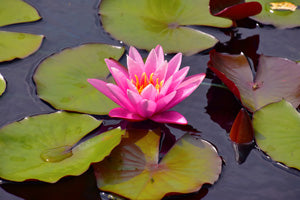An Introduction to Garden Ponds

A garden pond or water feature adds life and movement to any garden and can be a superb focal point or feature in almost any size garden.
Ponds can be supplied or constructed in a huge range of sizes and shapes, and the choices made will depend largely on the available space and what the pond is intended for. We will be happy to discuss the options here with you at Wharf Aquatics, and we have provided a short guide to the three main types below.
Wildlife Ponds

Adding a wildlife pond to your garden is one of the best ways to make your garden wildlife friendly and increase the diversity of your garden visitors. Almost any size of pond or feature will be beneficial, so it doesn't have to be large if space is limited. A wildlife pond is generally the simplest type of pond to install, as it doesn't need lots of equipment or expense. If you want to provide a home for a diverse array of wildlife, then it's important not to add any fish such as goldfish, as these will eat many of the small invertebrates that the pond's ecosystem depends on (small native fish such as sticklebacks would be ok). Without larger fish to support, there is also no need for larger filter units.
A wildlife pond can be little more than a small hole with a pond liner installed. If you choose a preformed pond, select one with multiple shelves and preferably a gradual slope on at least one side to allow easy access to the pond for wildlife, and ensure animals such as hedgehogs don't drown. If you will be using a pond liner and have space, dig out the pond area to include a deeper part (around 60cm / 2ft) and shallower areas for planting, with a gradual slope on at least one side.
Try to add a good variety of pond plants to provide shelter and habitat for different pond critters, these can include deep water oxygenators, floating plants and marginal plants - as well as other moisture-loving plants for the areas close to the pond. A bog garden (more attractive than it sounds) can be created next to the pond to provide additional habitat and an attractive feature in itself, where moisture-loving plants can thrive.
Garden Fish Ponds
A typical garden fish pond will usually house smaller pond fish such as goldfish and shubunkins, and may include some plants. Although it is possible to support a small number of fish in a pond without filtration, this type of pond will normally include a pond pump and filter to ensure the health of the fish and help keep the water clear. An ultra-violet (UV) clarifier is normally included as part of the filter system, which helps to keep the water clear and prevent "green water" algae growth.
As with a wildlife pond, a variety of plants can be included for a more natural look although goldfish and other carp species may feed on more delicate plants or root around in the pots - larger gravel or stones on top of the aquatic compost can help to minimise this.
A raised pond design may be safer if you have young children, and this sort of design often works well with modern outdoor spaces.
Koi Ponds

Ponds to house koi tend to be larger than other garden ponds and it is normally recommended that they have a minimum volume of 1,000 gallons / 4,500 litres (larger is better) and a water depth of at least 1m (3.3 ft), although 1.2 - 1.5m (4-5 ft) is better. Koi ponds will also require more heavy-duty filtration, as koi are long-lived fish that can grow quite large (60cm / 2ft plus).
To maximise swimming space and volume, koi ponds are often a more formal shape with steeper sides and a more "clinical" approach, although large natural ponds are possible. Plants are usually minimal in a koi pond, as most types are likely to be eaten, or their pots knocked over and rummaged through. It is possible to include some plants if a shallower area is incorporated - some designs incorporate a separate area built to one side to house plants and act as a "veggie filter" so that the benefits of live plants can be harnessed without the koi eating or disturbing them.
Products
View all
